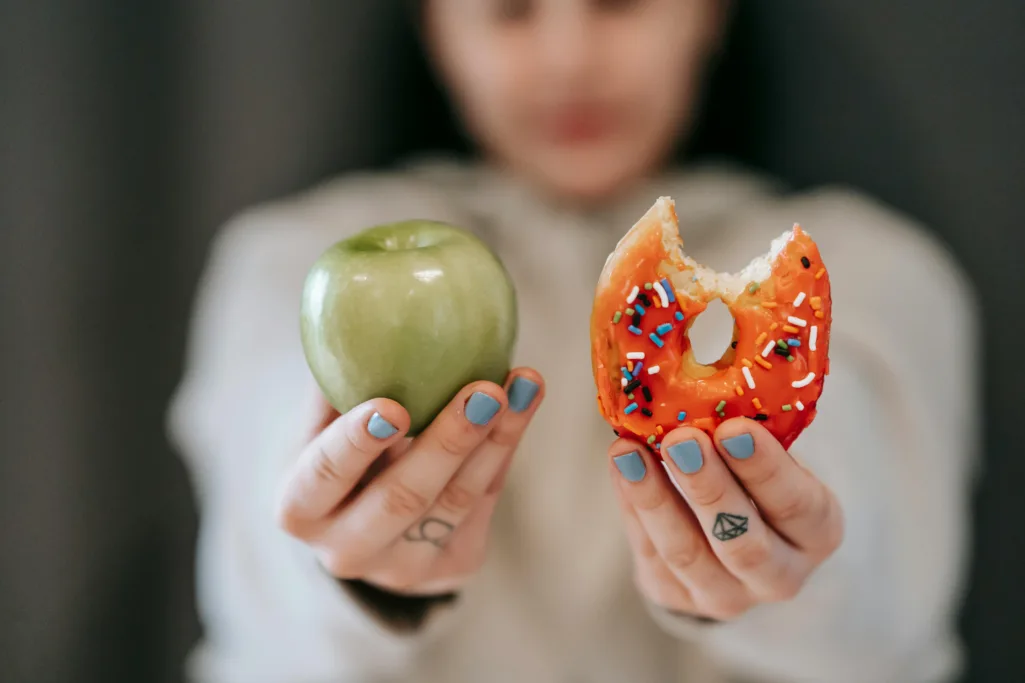Nutrition & Healthy Eating
Overcoming Temptation: Strategies for Avoiding Junk Food Cravings

Are you constantly battling the urge to reach for that bag of chips or indulge in a sugary treat?
Junk food cravings can be tough to resist, but with the right strategies, you can conquer them and stay on track with your health goals.
In this blog post, we will explore five practical tips to help you avoid junk food temptations and make healthier choices.
Key Takeaways:
- Understand Cravings: Biological, emotional, and stress factors trigger cravings.
- Healthy Alternatives: Stock your kitchen with nutritious options.
- Plan Ahead: Prepare meals and snacks to avoid impulsive choices.
- Mindful Eating: Savor each bite, listen to your body’s hunger cues.
- Healthy Environment: Organize your kitchen, avoid trigger foods.
TL;DR
Learn to conquer junk food cravings with strategies like stocking up on healthy alternatives, planning meals ahead, and practicing mindful eating.
Create a healthy eating environment by organizing your kitchen, avoiding trigger foods, and involving your family.
Practice mindful eating by savoring each bite, listening to your body’s cues, and being present during meals to avoid mindless snacking.
Table of Contents
Junk Food Cravings
Cravings, especially for junk food, can be quite powerful and intriguing. Have you ever wondered why you suddenly yearned for a bag of chips or a sweet treat?
One of the key aspects we’ll be looking at is the psychology behind these cravings. It’s not just about your taste buds wanting something specific; deeper mechanisms are at play.
Understanding the psychological factors that contribute to junk food cravings can provide valuable insights into how to manage and overcome them.
Next, we’ll touch upon the impact of junk food on your health. While indulging in a tasty snack now and then may seem harmless, regularly consuming junk food can have detrimental effects on your well-being.
From weight gain to nutrient deficiencies, the consequences of excessive junk food consumption are significant.
Lastly, we’ll discuss common triggers for cravings. These triggers can vary from person to person and can be influenced by various factors such as emotions, habits, and external cues.
Recognizing these triggers is the first step towards effectively managing and potentially reducing your junk food cravings.
Understanding the Causes of Cravings

Cravings can be powerful and hard to resist, but understanding the root causes behind them can help you navigate through them more effectively.
Let’s dive into the various factors that influence our cravings:
Biological Factors Influencing Cravings
Biological factors play a significant role in influencing our cravings. Our bodies are wired to seek out certain nutrients, leading to specific food cravings.
For example, craving salty foods may indicate a need for more sodium, while craving for sweets could signal a drop in blood sugar levels.
Additionally, hormonal fluctuations, nutrient deficiencies, and even genetics can all play a part in shaping our cravings.
Emotional and Psychological Triggers
Cravings are not purely physical; they can also be strongly tied to our emotions and psychological state.
Stress, boredom, loneliness, and even happy occasions can trigger cravings for comfort foods. Emotional eating is a common phenomenon, where we turn to food as a source of comfort or distraction.
Understanding your emotional triggers can help you address the root cause of your cravings and develop healthier coping mechanisms.
The Role of Stress in Craving Junk Food
Stress plays a significant role in driving cravings for junk food. When we are stressed, our bodies release cortisol, the “stress hormone,” which can increase appetite and intensify cravings, especially for high-fat and high-sugar foods.
These foods trigger the brain’s reward system, providing a temporary feel-good sensation. However, indulging in junk food as a response to stress can create a cycle of emotional eating and unhealthy habits.
Strategies to Avoid Junk Food Temptations

Do you often find yourself giving in to the temptation of junk food, even when you know it’s not the best choice for your health?
You’re not alone. Resisting the temptation of unhealthy snacks can be challenging, but with the right strategies in place, you can overcome those cravings and stay on track with your health goals.
Stocking up on Healthy Alternatives
One of the most effective ways to avoid giving in to junk food temptations is to stock up on healthy alternatives.
Fill your pantry and fridge with nutritious options like fruits, vegetables, nuts, and whole grains.
When you have these healthy choices readily available, you’ll be less likely to reach for that bag of chips or candy bar.
Planning Your Meals and Snacks in Advance
Another helpful strategy is to plan your meals and snacks.
By taking the time to decide what you’ll eat throughout the day, you can ensure that you have nutritious options on hand when hunger strikes.
This can help prevent impulsive decisions to indulge in junk food.
Practicing Mindful Eating
Mindful eating involves paying attention to your food choices and eating habits.
When you practice mindful eating, you are more likely to make conscious decisions about what you put into your body.
This can help you avoid mindlessly reaching for unhealthy snacks out of habit or boredom.
Staying Hydrated to Curb Cravings
Believe it or not, dehydration can sometimes be mistaken for hunger, leading you to crave unhealthy foods when your body is actually in need of hydration.
Staying properly hydrated throughout the day can help you stop cravings and reduce the urge to snack on junk food.
Engaging in Regular Physical Activity
Exercise not only benefits your physical health but also plays a crucial role in managing food cravings.
When you engage in regular physical activity, your body releases endorphins that help reduce stress and improve your mood.
This can make it easier to resist the temptation of junk food and make healthier choices overall.
Creating a Healthy Eating Environment

It all starts with the decisions you make in your kitchen.
Let’s dive into some key strategies to set yourself up for success.
Organizing your kitchen for success
Your kitchen layout and organization play a significant role in your eating habits.
By keeping healthy foods visible and easily accessible, you are more likely to reach for them when hunger strikes.
Start by decluttering your pantry and fridge, and discarding any processed or sugary items that may tempt you.
Arrange your fruits, vegetables, whole grains, and lean proteins in clear containers at eye level to encourage healthier choices.
Consider investing in storage containers and labeling them for added convenience.
Avoiding keeping trigger foods in the house
We all have trigger foods – those irresistible treats that call out to us in moments of weakness – cookies are mine 🙈.
The first step in overcoming these cravings is to simply not have them readily available in your space.
Eliminating or reducing the presence of unhealthy snacks or sugary indulgences in your kitchen removes the temptation to indulge mindlessly.
Instead, stock up on nutritious alternatives like nuts, seeds, yogurt, or chopped veggies for those snack cravings.
Involving your family in healthy eating habits
Healthy eating is a family affair, and it’s essential to create a supportive environment for everyone at home.
Involve your family members in meal planning, grocery shopping, and cooking to instill healthy habits from a young age.
Encourage open communication about food choices and preferences, making healthy eating a fun and collaborative experience.
Fostering a sense of shared responsibility, can reinforce positive behaviors and create lasting changes in your household.
Taking these small but impactful steps to organize your kitchen, avoid trigger foods, and involve your family in healthy eating habits sets the stage for a healthier and happier lifestyle.
Remember that every positive choice brings you closer to your wellness goals!
Mindful Eating Practices

When it comes to mindful eating, there are a few key practices that can help you develop a healthier relationship with food.
Focusing on these principles can improve your overall well-being and satisfaction with meals.
Eating Slowly and Savoring Each Bite
One important aspect of mindful eating is to slow down during meals and truly savor each bite.
Chewing your food slowly and being present at the moment can help you appreciate the flavors and textures of what you’re eating.
This can also help prevent overeating, as it gives your brain more time to register when you’re full.
Listening to Your Body’s Hunger and Fullness Cues
Learning to listen to your body’s cues for hunger and fullness is another essential part of mindful eating.
Pay attention to how your body feels before, during, and after meals. Eat when you’re truly hungry and stop when you’re satisfied, rather than relying on external cues or eating out of habit.
Being Present During Meals to Avoid Mindless Snacking
Many of us are guilty of mindless snacking, whether out of boredom, stress, or habit. I know I am!
Being present during meals can help you avoid this trap. Turn off distractions like the TV or phone, and focus on the experience of eating.
Conclusion
Understanding the root causes of junk food cravings and implementing practical strategies can help us make healthier choices.
Stocking up on nutritious alternatives, planning meals, practicing mindful eating, and creating a supportive environment at home, can help us overcome temptations and improve our overall well-being.
Awareness, moderation, and mindful decision-making are key in navigating the challenges posed by junk food cravings and promoting a healthier lifestyle.
FAQ
What are some common triggers for junk food cravings?
Common triggers include biological factors like nutrient deficiencies, emotional and psychological factors like stress or boredom, and environmental cues.
How does stress contribute to junk food cravings?
Stress triggers the release of cortisol, the “stress hormone,” which can increase appetite and intensify cravings, especially for high-fat and high-sugar foods.
What are some strategies mentioned to avoid junk food temptations?
Strategies include stocking up on healthy alternatives, planning meals and snacks in advance, practicing mindful eating, staying hydrated, and engaging in regular physical activity.
How can I create a healthier eating environment at home?
You can create a healthier environment by organizing your kitchen for success, avoiding keeping trigger foods in the house, and involving your family in healthy eating habits.
What are some mindful eating practices mentioned in the post?
Mindful eating practices include eating slowly and savoring each bite, listening to your body’s hunger and fullness cues, and being present during meals to avoid mindless snacking.



